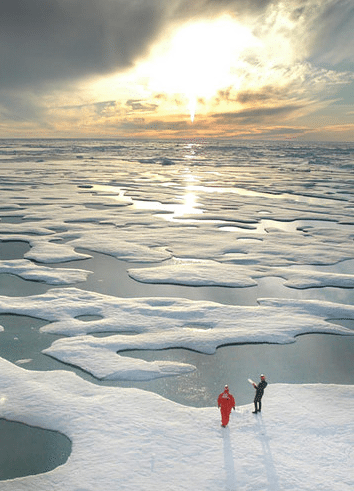 NOAA, Shell , ConocoPhillips, and Statoil today signed an agreement to collaborate on scientific ocean, coastal and climate data for the Arctic. The agreement facilitates the sharing of data sets on ocean/weather observations, biological information, sea ice and sea floor mapping studies.
NOAA, Shell , ConocoPhillips, and Statoil today signed an agreement to collaborate on scientific ocean, coastal and climate data for the Arctic. The agreement facilitates the sharing of data sets on ocean/weather observations, biological information, sea ice and sea floor mapping studies.
The agreement provides a framework to share quality data that will enhance NOAA’s ability to monitor climate change and provide useful products that inform responsible energy exploration activities in the region. The integration of this data to NOAA’s portfolio will provide a greater national capacity to effectively manage and respond to environmental disasters, such as hazardous spills, in an area where limited personnel and facilities exist.
NOAA will conduct quality control on all data provided to the agency under this agreement in compliance with OMB and NOAA guidelines plus implementing the information through peer review. Consistent with NOAA’s commitment to openness and transparency NOAA will make most of the data obtained under this agreement available to the public except as limited by a specific annex of the agreement.
While NOAA’s data is generally available to the public, types of data the companies have
agreed to share with the government address issues including:
• Meteorology
• Coastal and Ocean Currents, Circulation, and Waves
• Sea Ice Studies
• Biological Science
• Hydrographic Services and mapping.
A dramatic reduction in sea ice as a result of climate change raises new environmental, economic, and national security issues that have immediate and long-term impacts for human lives, livelihoods, coastal communities and the environment and demand extensive and collaborative analysis.
“Despite the wealth of scientific research conducted on the Arctic environment to date, much remains unknown, and no single government agency or entity has the resources or capacity to meet the task alone,” said NOAA administrator Jane Lubchenco, under secretary of commerce for oceans and atmosphere. “This innovative partnership will significantly expand NOAA’s access to important data, enhance our understanding of the region and improve the United States’ ability to manage critical environmental issues efficiently and effectively as climate change continues to impact the Arctic.”
The collaboration will leverage existing assets and strengths of the signatories bringing NOAA’s scientific expertise together with the industry partner’s offshore experience and science initiatives. Data and information will be shared with the public through NOAA’s existing products and services to the extent possible, in accordance with applicable laws, regulations, and procedures.
“We will hold our industry partners to our high standards, and make sure that as we learn more, we also prepare for and minimize the risks involved in Arctic oil and gas development,” said Lubchenco. “Consistent with our commitment to quality-check data and make public as much of it as possible, we anticipate being able to take advantage of multiple sources of information. In view of the rapid of change in Arctic ecosystems and populations, additional credible courses of data are welcome.”
Products and data from this collaboration will help NOAA achieve many of the goals it has for the Arctic. Earlier this year, NOAA released its Arctic Vision and Strategy, a document crafted to address Presidential directives on the Arctic, including the U.S. Arctic Region Policy and the National Ocean Policy, as well as the needs and requirements articulated by NOAA partners and stakeholders for Arctic services. The Vision and Strategy encompasses all of NOAA’s capabilities, including fisheries management, weather and sea forecasting, climate services, mapping and charting for safe navigation, oil spill readiness and response, observations by satellite, ship, and aircraft, and oceanic, atmospheric, and climate research. NOAA’s mission is to understand and predict changes in the Earth’s environment, from the depths of the ocean to the surface of the sun, and to conserve and manage our coastal and marine resources.

 Join The Club
Join The Club




 NOAA, Shell , ConocoPhillips, and Statoil today signed
NOAA, Shell , ConocoPhillips, and Statoil today signed 






